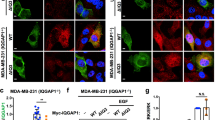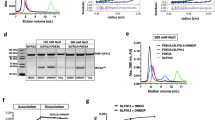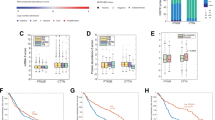Abstract
We have reported previously the development of small-molecule phosphatidylinositol-3,4,5-trisphosphate (PIP3) antagonists (PITs) that block pleckstrin homology (PH) domain interaction, including activation of Akt, and show anti-tumor potential. Here we show that the same molecules inhibit growth factor-induced actin remodeling, lamellipodia formation and, ultimately, cell migration and invasion, consistent with an important role of PIP3 in these processes. In vivo, a PIT-1 analog displays significant inhibition on tumor angiogenesis and metastasis. ADP ribosylation factor 6 (ARF6) was recently identified as an important mediator of cytoskeleton and cell motility, which is regulated by PIP3-dependent membrane translocation of the guanine nucleotide exchange factors (GEFs), such as ADP-ribosylation factor nucleotide binding site opener (ARNO) and general receptor for 3-phosphoinositides (GRP1). We demonstrate that PITs inhibit PIP3/ARNO or GRP1 PH domain binding and membrane localization, resulting in the inhibition of ARF6 activation. Importantly, we show that expression of the constitutively active mutant of ARF6 attenuates inhibition of lamellipodia formation and cell migration by PITs, confirming that inhibition of ARF6 contributes to inhibition of these processes by PITs. Overall, our studies demonstrate the feasibility of developing specific small-molecule targeting PIP3 binding by PH domains as potential anticancer agents that can simultaneously interfere with cancer development at multiple points.
This is a preview of subscription content, access via your institution
Access options
Subscribe to this journal
Receive 50 print issues and online access
$259.00 per year
only $5.18 per issue
Buy this article
- Purchase on Springer Link
- Instant access to full article PDF
Prices may be subject to local taxes which are calculated during checkout








Similar content being viewed by others
References
Avraamides CJ, Garmy-Susini B, Varner JA . (2008). Integrins in angiogenesis and lymphangiogenesis. Nat Rev Cancer 8: 604–617.
Balana ME, Niedergang F, Subtil A, Alcover A, Chavrier P, Dautry-Varsat A . (2005). ARF6 GTPase controls bacterial invasion by actin remodelling. J Cell Sci 118: 2201–2210.
Cantley LC . (2002). The phosphoinositide 3-kinase pathway. Science 296: 1655–1657.
Caumont AS, Vitale N, Gensse M, Galas MC, Casanova JE, Bader MF . (2000). Identification of a plasma membrane-associated guanine nucleotide exchange factor for ARF6 in chromaffin cells. Possible role in the regulated exocytotic pathway. J Biol Chem 275: 15637–15644.
Cavenagh MM, Whitney JA, Carroll K, Zhang C, Boman AL, Rosenwald AG et al. (1996). Intracellular distribution of Arf proteins in mammalian cells. Arf6 is uniquely localized to the plasma membrane. J Biol Chem 271: 21767–21774.
Chardin P, Paris S, Antonny B, Robineau S, Beraud-Dufour S, Jackson CL et al. (1996). A human exchange factor for ARF contains Sec7- and pleckstrin-homology domains. Nature 384: 481–484.
Cox R, Mason-Gamer RJ, Jackson CL, Segev N . (2004). Phylogenetic analysis of Sec7-domain-containing Arf nucleotide exchangers. Mol Biol Cell 15: 1487–1505.
Donaldson JG . (2003). Multiple roles for Arf6: sorting, structuring, and signaling at the plasma membrane. J Biol Chem 278: 41573–41576.
Esteban PF, Yoon HY, Becker J, Dorsey SG, Caprari P, Palko ME et al. (2006). A kinase-deficient TrkC receptor isoform activates Arf6-Rac1 signaling through the scaffold protein tamalin. J Cell Biol 173: 291–299.
Frank S, Upender S, Hansen SH, Casanova JE . (1998a). ARNO is a guanine nucleotide exchange factor for ADP-ribosylation factor 6. J Biol Chem 273: 23–27.
Frank SR, Hatfield JC, Casanova JE . (1998b). Remodeling of the actin cytoskeleton is coordinately regulated by protein kinase C and the ADP-ribosylation factor nucleotide exchange factor ARNO. Mol Biol Cell 9: 3133–3146.
Gillingham AK, Munro S . (2007). The small G proteins of the Arf family and their regulators. Annu Rev Cell Dev Biol 23: 579–611.
Hafner M, Schmitz A, Grune I, Srivatsan SG, Paul B, Kolanus W et al. (2006). Inhibition of cytohesins by SecinH3 leads to hepatic insulin resistance. Nature 444: 941–944.
Hashimoto S, Onodera Y, Hashimoto A, Tanaka M, Hamaguchi M, Yamada A et al. (2004). Requirement for Arf6 in breast cancer invasive activities. Proc Natl Acad Sci USA 101: 6647–6652.
Hornstein I, Alcover A, Katzav S . (2004). Vav proteins, masters of the world of cytoskeleton organization. Cell Signal 16: 1–11.
Hu B, Shi B, Jarzynka MJ, Yiin JJ, D'Souza-Schorey C, Cheng SY . (2009). ADP-ribosylation factor 6 regulates glioma cell invasion through the IQ-domain GTPase-activating protein 1-Rac1-mediated pathway. Cancer Res 69: 794–801.
Jackson CL, Casanova JE . (2000). Turning on ARF: the Sec7 family of guanine-nucleotide-exchange factors. Trends Cell Biol 10: 60–67.
Kavran JM, Klein DE, Lee A, Falasca M, Isakoff SJ, Skolnik EY et al. (1998). Specificity and promiscuity in phosphoinositide binding by pleckstrin homology domains. J Biol Chem 273: 30497–30508.
Klarlund JK, Guilherme A, Holik JJ, Virbasius JV, Chawla A, Czech MP . (1997). Signaling by phosphoinositide-3,4,5-trisphosphate through proteins containing pleckstrin and Sec7 homology domains. Science 275: 1927–1930.
Klarlund JK, Rameh LE, Cantley LC, Buxton JM, Holik JJ, Sakelis C et al. (1998). Regulation of GRP1-catalyzed ADP ribosylation factor guanine nucleotide exchange by phosphatidylinositol 3,4,5-trisphosphate. J Biol Chem 273: 1859–1862.
Langille SE, Patki V, Klarlund JK, Buxton JM, Holik JJ, Chawla A et al. (1999). ADP-ribosylation factor 6 as a target of guanine nucleotide exchange factor GRP1. J Biol Chem 274: 27099–27104.
Macia E, Luton F, Partisani M, Cherfils J, Chardin P, Franco M . (2004). The GDP-bound form of Arf6 is located at the plasma membrane. J Cell Sci 117: 2389–2398.
Macia E, Partisani M, Favard C, Mortier E, Zimmermann P, Carlier MF et al. (2008). The pleckstrin homology domain of the Arf6-specific exchange factor EFA6 localizes to the plasma membrane by interacting with phosphatidylinositol 4,5-bisphosphate and F-actin. J Biol Chem 283: 19836–19844.
Miao B, Skidan I, Yang J, Lugovskoy A, Reibarkh M, Long K et al. (2010). Small molecule inhibition of phosphatidylinositol-3,4,5-triphosphate (PIP3) binding to pleckstrin homology domains. Proc Natl Acad Sci USA 107: 20126–20131.
Muralidharan-Chari V, Hoover H, Clancy J, Schweitzer J, Suckow MA, Schroeder V et al. (2009). ADP-ribosylation factor 6 regulates tumorigenic and invasive properties in vivo. Cancer Res 69: 2201–2209.
Nie Z, Hirsch DS, Randazzo PA . (2003). Arf and its many interactors. Curr Opin Cell Biol 15: 396–404.
Park WS, Heo WD, Whalen JH, O'Rourke NA, Bryan HM, Meyer T et al. (2008). Comprehensive identification of PIP3-regulated PH domains from C. elegans to H. sapiens by model prediction and live imaging. Mol Cell 30: 381–392.
Renault L, Guibert B, Cherfils J . (2003). Structural snapshots of the mechanism and inhibition of a guanine nucleotide exchange factor. Nature 426: 525–530.
Ridley AJ, Paterson HF, Johnston CL, Diekmann D, Hall A . (1992). The small GTP-binding protein rac regulates growth factor-induced membrane ruffling. Cell 70: 401–410.
Santy LC, Casanova JE . (2001). Activation of ARF6 by ARNO stimulates epithelial cell migration through downstream activation of both Rac1 and phospholipase D. J Cell Biol 154: 599–610.
Simpson KJ, Dugan AS, Mercurio AM . (2004). Functional analysis of the contribution of RhoA and RhoC GTPases to invasive breast carcinoma. Cancer Res 64: 8694–8701.
Tague SE, Muralidharan V, D'Souza-Schorey C . (2004). ADP-ribosylation factor 6 regulates tumor cell invasion through the activation of the MEK/ERK signaling pathway. Proc Natl Acad Sci USA 101: 9671–9676.
Varnai P, Bondeva T, Tamas P, Toth B, Buday L, Hunyady L et al. (2005). Selective cellular effects of overexpressed pleckstrin-homology domains that recognize PtdIns(3,4,5)P3 suggest their interaction with protein binding partners. J Cell Sci 118: 4879–4888.
Venkateswarlu K, Oatey PB, Tavare JM, Cullen PJ . (1998). Insulin-dependent translocation of ARNO to the plasma membrane of adipocytes requires phosphatidylinositol 3-kinase. Curr Biol 8: 463–466.
Viaud J, Zeghouf M, Barelli H, Zeeh JC, Padilla A, Guibert B et al. (2007). Structure-based discovery of an inhibitor of Arf activation by Sec7 domains through targeting of protein-protein complexes. Proc Natl Acad Sci USA 104: 10370–10375.
Vivanco I, Sawyers CL . (2002). The phosphatidylinositol 3-Kinase AKT pathway in human cancer. Nat Rev Cancer 2: 489–501.
Wang F, Herzmark P, Weiner OD, Srinivasan S, Servant G, Bourne HR . (2002). Lipid products of PI(3)Ks maintain persistent cell polarity and directed motility in neutrophils. Nat Cell Biol 4: 513–518.
Yang CZ, Heimberg H, D'Souza-Schorey C, Mueckler MM, Stahl PD . (1998). Subcellular distribution and differential expression of endogenous ADP-ribosylation factor 6 in mammalian cells. J Biol Chem 273: 4006–4011.
Acknowledgements
We thank Dr Joan Brugge (Harvard Medical School), Dr Tamas Balla (National Institutes of Health) and Dr Philippe Chavrier (Institut Curie) for the gifts of plasmids and cells. We thank Dr Jeff Peterson (Fox Chase Cancer Center, Philadelphia, PA, USA) for providing valuable comments. This work was supported by Smith Family Award for Excellence in Biomedical Research and National Institute on Aging Mentored Research Scientist Career Development Award (to AD), an Innovator Award from US Army (DAMD17-02-1-0403), National Cancer Institute (RO1 CA34722/PO1-50661) (to BSS) and the National Institute on Aging (R37 AG012859) (to JY).
Author information
Authors and Affiliations
Corresponding author
Ethics declarations
Competing interests
The authors declare no conflict of interest.
Additional information
Supplementary Information accompanies the paper on the Oncogene website
Rights and permissions
About this article
Cite this article
Miao, B., Skidan, I., Yang, J. et al. Inhibition of cell migration by PITENINs: the role of ARF6. Oncogene 31, 4317–4332 (2012). https://doi.org/10.1038/onc.2011.593
Received:
Revised:
Accepted:
Published:
Issue Date:
DOI: https://doi.org/10.1038/onc.2011.593
Keywords
This article is cited by
-
LINC01468 drives NAFLD-HCC progression through CUL4A-linked degradation of SHIP2
Cell Death Discovery (2022)
-
Pals1 functions in redundancy with SMAP1 to inhibit Arf6 in order to prevent Rac1-dependent colorectal cancer cell migration and invasion
Cancer Gene Therapy (2022)
-
Endocytosis: a pivotal pathway for regulating metastasis
British Journal of Cancer (2021)
-
Lectin RCA-I specifically binds to metastasis-associated cell surface glycans in triple-negative breast cancer
Breast Cancer Research (2015)



